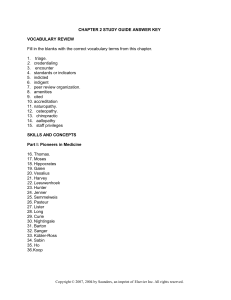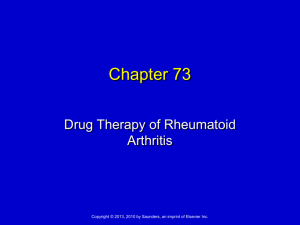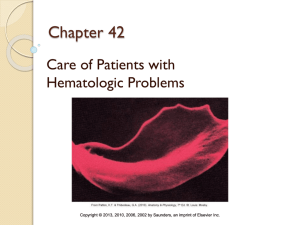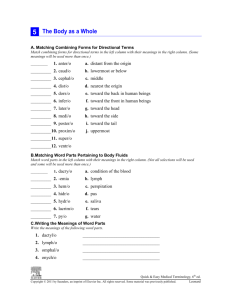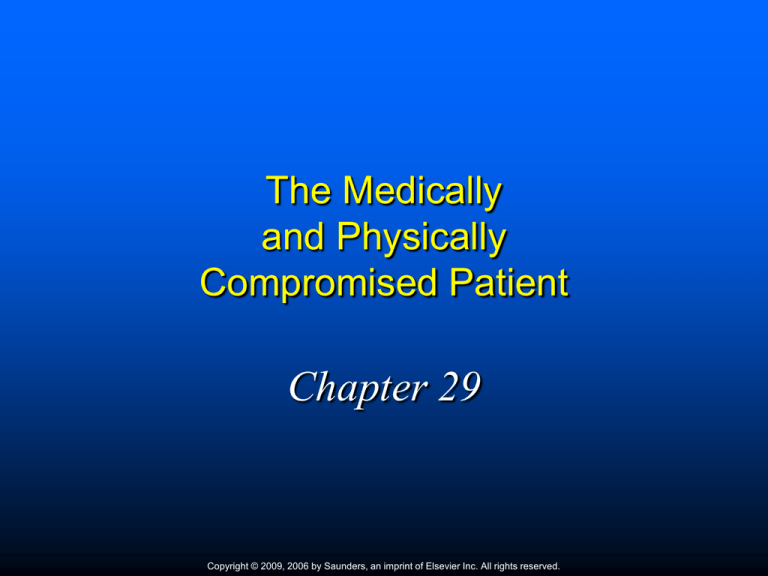
The Medically
and Physically
Compromised Patient
Chapter 29
Copyright © 2009, 2006 by Saunders, an imprint of Elsevier Inc. All rights reserved.
Chapter 29
Lesson 29.1
Copyright © 2009, 2006 by Saunders, an imprint of Elsevier Inc. All rights reserved.
Learning Objectives
Pronounce, define, and spell the Key Terms.
Describe the type of dental management a
medically compromised patient would
receive.
Describe the stages of aging in the older
population.
Describe orally related conditions affecting
the older patient.
(Cont’d)
Copyright © 2009, 2006 by Saunders, an imprint of Elsevier Inc. All rights reserved.
Learning Objectives
(Cont’d)
Describe the importance of the medical
history in the medically compromised patient.
Describe the major medical disorders that
can affect a patient’s oral health.
Copyright © 2009, 2006 by Saunders, an imprint of Elsevier Inc. All rights reserved.
The Rights of a Patient
Americans with Disabilities Act
Provides a clear, strong, enforceable standard
addressing discrimination against people with
disabilities
American Dental Association
Supports:
• Title I: employment discrimination
• Title II: access for the disabled
• Title III: public accommodations
• Title IV: telecommunications services
Copyright © 2009, 2006 by Saunders, an imprint of Elsevier Inc. All rights reserved.
Role of the Dental Assistant
Aid the dentist in providing treatment.
Act as a source of information to the patient
and family.
Provide comfort to the patient.
Help reduce anxiety.
Copyright © 2009, 2006 by Saunders, an imprint of Elsevier Inc. All rights reserved.
The Aging Population
Aging is the irreversible and inevitable
changes that occur with time.
Stages of the older population:
Young/old: People 65 to 74 years old, better educated and
more demanding of health services, retain more of their
natural teeth.
Old: People 75 to 84 years old, beginning to have multiple
health problems, have more fixed and removable
prostheses.
Old/old: People 85 years old or older have fewer natural
teeth, believe that tooth loss is inevitable, and have medical
conditions reflected in their oral health.
Copyright © 2009, 2006 by Saunders, an imprint of Elsevier Inc. All rights reserved.
Dentally Related Aging Changes
Xerostomia is a condition, resulting from certain
disorders and medications, that involves decreased
flow of saliva.
Periodontal disease is an increasing problem in the
older population. The tissues of older patients may be
slower to heal.
Dental decay increases in the form of coronal and
root caries and recurrent decay around defective
restorations.
Dark and brittle teeth result from deposition of
secondary dentin that have gradually reduced the
size of the pulp chamber.
Bone resorption results in loss of the alveolar ridge.
Copyright © 2009, 2006 by Saunders, an imprint of Elsevier Inc. All rights reserved.
Fig. 29-3 Periodontal conditions of an older patient.
Copyright © 2009, 2006 by Saunders, an imprint of Elsevier Inc. All rights reserved.
Fig. 29-4 Root caries of in an older patient.
Copyright © 2009, 2006 by Saunders, an imprint of Elsevier Inc. All rights reserved.
Fig. 29-5 Darkened teeth associated with
secondary dentin and aging.
Copyright © 2009, 2006 by Saunders, an imprint of Elsevier Inc. All rights reserved.
Fig. 29-6 Bone resorption with loss of teeth and
alveolar ridge.
Copyright © 2009, 2006 by Saunders, an imprint of Elsevier Inc. All rights reserved.
The Medically Compromised Patient
Patient Assessment
Category I: Healthy patient
Category II: Medical conditions requiring schedule
changes
Category III: Medical conditions requiring
significant modifications in dental treatment
Category IV: Medical conditions requiring major
modifications in dental treatment
Category V: Serious medical conditions
Copyright © 2009, 2006 by Saunders, an imprint of Elsevier Inc. All rights reserved.
Neurologic Disorders
Alzheimer disease is a brain disorder that is
marked by deterioration of mental capacity.
The disease progresses in three stages:
• Early disease, or forgetfulness phase
• Intermediate disease, or confused phase
• Late disease, or dementia phase
Treatment-plan modifications
Thorough dental examination in early stages
Special attention to daily care of the mouth
Alertness to signs of xerostomia
(Cont’d)
Copyright © 2009, 2006 by Saunders, an imprint of Elsevier Inc. All rights reserved.
Neurologic Disorders
(Cont’d)
Seizures are an abrupt suspension of motor,
sensory, and/or body function.
Epilepsy
Petit mal seizures usually last 5 to 10 seconds.
Grand mal seizures have many causes and arise in people
in all age groups.
Treatment-plan modifications
Maintenance of oral hygiene
Surgical reduction of gingival hyperplasia
Questioning before any procedure with regard to eating,
stress, pain, and alcohol consumption.
(Cont’d)
Copyright © 2009, 2006 by Saunders, an imprint of Elsevier Inc. All rights reserved.
Neurologic Disorders
Multiple sclerosis is a debilitating and
degenerative disorder of the central nervous
system that involves progressive weakening
of the lower extremities, causing muscle
weakness, unsteady gait, and paralysis.
Treatment-plan modifications
Adrenal suppressants to relax muscles.
Extra time for procedures, if the patient is
wheelchair-bound
(Cont’d)
Copyright © 2009, 2006 by Saunders, an imprint of Elsevier Inc. All rights reserved.
Neurologic Disorders
(Cont’d)
Stroke, or cerebrovascular accident, is a
minor to severe loss of central nervous
system function caused by a sudden vascular
lesion of the brain, such as hemorrhage,
embolism, thrombosis, or ruptured aneurysm.
Treatment-plan modifications
Midmorning scheduling with additional time
set aside
Modification of oral-hygiene aids
Copyright © 2009, 2006 by Saunders, an imprint of Elsevier Inc. All rights reserved.
Cardiovascular Disorders
Heart disease: leading cause of death in the
United States
Angina: severe pain in the chest associated with
an insufficient supply of blood to the heart
Myocardial infarction: heart attack
Treatment-plan modifications
• Vital-sign checks throughout the procedure
• Use of supplemental oxygen
• Use of prophylactic sublingual nitroglycerin
• Avoidance of epinephrine
(Cont’d)
Copyright © 2009, 2006 by Saunders, an imprint of Elsevier Inc. All rights reserved.
Cardiovascular Disorders
(Cont’d)
Hypertension: Referred to as high blood
pressure, it results when the heart must work
harder as it pumps against resistance (e.g., a
blocked artery).
Major factors associated with hypertension:
Stress
Age
Heredity
Smoking
Obesity
(Cont’d)
Copyright © 2009, 2006 by Saunders, an imprint of Elsevier Inc. All rights reserved.
Cardiovascular Disorders
(Cont’d)
Congestive heart failure is a condition where the
heart cannot pump enough blood to the body’s other
organs.
This lack of circulation throughout the body can result
from:
Narrowed arteries
Interference with the heart muscle by scar tissue from a past heart
attack
High blood pressure
Heart-valve disease
Heart defect
Infection of the heart valve or muscle
(endocarditis or myocarditis)
(Cont’d)
Copyright © 2009, 2006 by Saunders, an imprint of Elsevier Inc. All rights reserved.
Cardiovascular Disorders
(Cont’d)
A patient with cardiac disease or a prosthetic
replacement carries an increased risk of
infection with bacteria carried in the blood.
Endocarditis is a severe infection of the
cardiac valves and supporting structures
caused by bloodborne pathogens that gain
entry to the bloodstream from such places as
the mouth and gastrointestinal tract.
Copyright © 2009, 2006 by Saunders, an imprint of Elsevier Inc. All rights reserved.
Chapter 29
Lesson 29.2
Copyright © 2009, 2006 by Saunders, an imprint of Elsevier Inc. All rights reserved.
Learning Objectives
Describe the major medical disorders that
can affect a patient’s oral health.
Describe the type of dental management a
medically compromised patient would
receive.
Demonstrate the correct transfer of a
wheelchair-bound patient.
Copyright © 2009, 2006 by Saunders, an imprint of Elsevier Inc. All rights reserved.
Pulmonary Disorders
Disorders that affect the lungs and are
characterized by airway obstruction.
Bronchial asthma: Often arising from allergies
characterized by an increased hypersensitivity to
various stimuli, which results in bronchial edema
and widespread narrowing of the bronchial
airways.
Treatment-plan modifications
• Minimizing stress
• Shortening appointments
• Minimizing the use of epinephrine and aspirin
(Cont’d)
Copyright © 2009, 2006 by Saunders, an imprint of Elsevier Inc. All rights reserved.
Pulmonary Disorders
(Cont’d)
“Chronic obstructive pulmonary disease” is
the general term for pulmonary diseases
characterized by airflow blockage during
respiration.
Bronchitis is a narrowing of the bronchial
airways resulting from chronic inflammation.
Emphysema is an irreversible enlargement of
the size of the air spaces, resulting in labored
breathing and increased susceptibility to
infection.
(Cont’d)
Copyright © 2009, 2006 by Saunders, an imprint of Elsevier Inc. All rights reserved.
Pulmonary Disorders
(Cont’d)
Treatment-plan modifications
Minimizing stress
Shortening appointments
Setting morning appointments
Considering the use of sedation techniques
Consider the use of humidified oxygen
Refraining from fully reclining the patient
Avoidance of anticholinergic drugs
Avoidance of appointments in hot and humid
weather
Copyright © 2009, 2006 by Saunders, an imprint of Elsevier Inc. All rights reserved.
Blood Disorders
Disorders that involve the cellular elements of
the body
Leukemia is an excessive increase in the number
of white blood cells.
Hemophilia is a disease marked by excessive
bleeding, caused by a congenital lack of a protein
substance necessary for blood clotting.
Treatment-plan modifications
Make modifications for any surgical procedures.
Antibiotic prophylaxis may need to be prescribed
for high-risk procedures.
Copyright © 2009, 2006 by Saunders, an imprint of Elsevier Inc. All rights reserved.
Muscular Disorders
The musculoskeletal system includes the
bones, muscles, and joints.
Older patients are more likely to have chronic
progressive arthritis with stiffening of joints.
Muscular dystrophy involves the striated muscles
in the body, resulting in progressive atrophy and
weakness.
Treatment-plan ,odifications
See arthritic patients in the morning.
Avoid sedation in patients whose breathing is
impaired.
Copyright © 2009, 2006 by Saunders, an imprint of Elsevier Inc. All rights reserved.
Endocrine Disorders
Glands throughout the body release
hormones into the bloodstream to help
regulate the metabolism.
Hyperthyroid is an overactive thyroid gland.
Hypothyroid is an underactive thyroid gland that
produces fewer hormones.
Treatment-plan modifications
Medical consultation is essential.
Such patients are highly sensitive to epinephrine
and other “amine” anesthetics.
(Cont’d)
Copyright © 2009, 2006 by Saunders, an imprint of Elsevier Inc. All rights reserved.
Endocrine Disorders
(Cont’d)
Diabetes mellitus is a disease characterized
by a sustained high blood glucose level
resulting from an absolute or a relative lack of
insulin.
• Type 1 disease renders the patient insulin- dependent.
• Type 2 disease is controlled with the use of diet and
oral medications.
Treatment-plan modifications
• Minimizing stress
• Schedule appointments for midmorning
• Use of sedation techniques
• Normal dietary intake before treatment
Copyright © 2009, 2006 by Saunders, an imprint of Elsevier Inc. All rights reserved.
Behavioral and Psychiatric Disorders
Anxiety is a feeling of impending disaster.
Depression is a condition of general
emotional rejection and withdrawal.
Schizophrenia is a disturbance in thinking
and perception with delusions, hallucinations,
and impaired reality testing.
Treatment-plan modifications
Addition of a fluoride supplement and salivary
substitutes because of xerostomia
Importance of regular hygiene
Understanding that gaining informed consent may be
difficult
Copyright © 2009, 2006 by Saunders, an imprint of Elsevier Inc. All rights reserved.
The Physically Compromised Patient
Wheelchair-bound patient
Vision-impaired patient
Transferring the patient is a concern.
This patient relies on his or her sense of touch and
oral communication.
Hearing-impaired patient
Face your patient.
Speak slowly.
Keep directions simple.
Give written instructions.
Copyright © 2009, 2006 by Saunders, an imprint of Elsevier Inc. All rights reserved.





